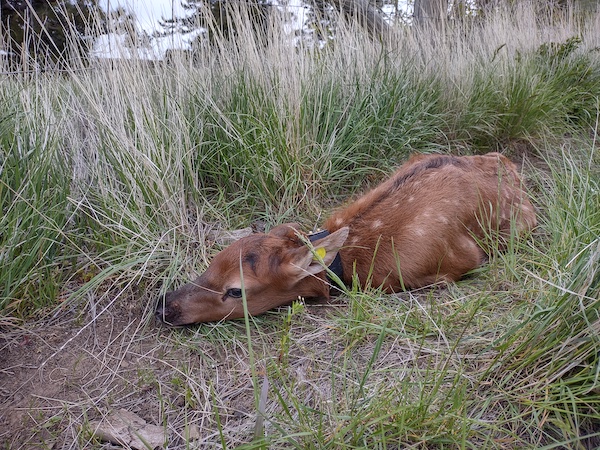
Year 2 Of Blue Mountain Elk Calf Captures Fall Short Of Goal
Year two of WDFW’s elk calf capture-collar effort in the Blue Mountains has wrapped up but it fell short of the project’s goal, with only 102 of the young wapiti outfitted with a tracking device as the agency studies the reasons why so many are dying.
Biologists had wanted to get collars onto 125 calves from this hard-bitten elk herd and were able to meet benchmarks in two game management units but fell short in the third, Tucannon.

WDFW spokeswoman Sam Montgomery attributed that to “complications with weather – preventing capture from ground and air – and there were fewer available calves to capture within that GMU.”
Tucannon and the other two units – Lick Creek and Dayton – lie on the northern side of the Southeast Washington mountain range.
During open public input in front of the Washington Fish and Wildlife Commission this morning, Justin Dixon, a Garfield County Commissioner, told members that the difficulty finding calves reflected predator problems in the Blues, where cougars, bruins and now wolves, plus other carnivores, prey on the once-strong elk herd.
All but nine of last year’s 125-calf cohort had died by this past March, with 77 known to have succumbed to predation and at least 57 of those by the fangs of cougars.
Dixon asked members of the citizen panel that sets WDFW policy for “assistance managing the predators that we have a problem with,” following up on a similar January request from all four Evergreen State counties bucked up by this basaltic mountain range.
WDFW is proposing to issue second cougar tags here and tomorrow the commission will be briefed by agency managers and hold a public hearing on it.
A number of hunting organizations and hunters spoke this morning in favor of the proposal, as well as called for reinstatement of the spring black bear hunt, which the commission controversially cancelled for 2022. Even if only 139 bruin permits would have been available this year, it’s possible hunters could have disrupted bear predation on the spring elk birth pulse, not to mention removed some boars.
“We are losing elk faster than they can be replaced,” Mike Herz, a member of Howl for Wildlife and the Sportsmen’s Alliance, told the commission. “At some point the well will run dry.”
The latest estimate from this spring is that there are around 3,600 elk on the Washington side of the Blues, far below the management objective of 5,500. A population assessment last year classified the herd as “at risk.”
The postwinter calf:cow ratio of 17:100 is also the lowest since 2000. That level is “insufficient to reverse the decline,” per a WDFW presentation on the matter and which also states, “Main cause of poor calf survival is predation” and the “main predator is cougar.”
The killer winter of 2016-17 started the herd’s decline and recent years have seen drought conditions. Cougar advocates blame environmental conditions and say the herd is starving more so than is stuck in a predator pit.
While wolf numbers have increased markedly here and are a flashpoint among hunters and ranchers, studies in Montana and Idaho found cougars accounted for higher rates of calf and cow elk mortality. Perhaps there is some dynamic leading to the deaths of more elk with three primary predators on the landscape than just two, as it was before wolves moved into the Blues in force.
WDFW’s proposed short-term two-tag fix, which would take effect this coming season if approved at the commission’s July 15 meeting, aims to reduce mountain lion density and increase the survival of calves. This past cougar hunt saw 19 cats taken in the Blues; up to 22 could have been under the current season structure, which limits harvest to 12 to 16 percent of the population.
Anis Aoude, WDFW’s Game Division manager who is based in Olympia, had a chance to get out of the office for the calf capture operations. He said that even though biologists didn’t capture 125 this spring, he thinks having collars on 102 is still “going to be sufficient” from a scientific validity standpoint.
Some commissioners routinely question agency science and data.
Aoude said more effort this spring went into catching neonates on the ground in their first one to three days of life than from the air. He considered missing last year’s calf benchmark “more a logistic thing” as biologists didn’t want to keep chasing already-calf-checked elk subgroups in the Tucannon around in a helicopter and wasting money
He also reported that some calves’ collars have already given off mortality signals, not unexpected as many die in their first few weeks – but frustrating all the same for this famed elk herd’s recovery.
Correction, 1:12 p.m., Friday, June 24, 2022: The initial version of this blog incorrectly stated that all but nine of the 125 calves had survived their first 10 months – if only! – but in fact only nine of the 125 were known to still be alive. Andy “Fingers of Flame” has been sent to his room for the error.
